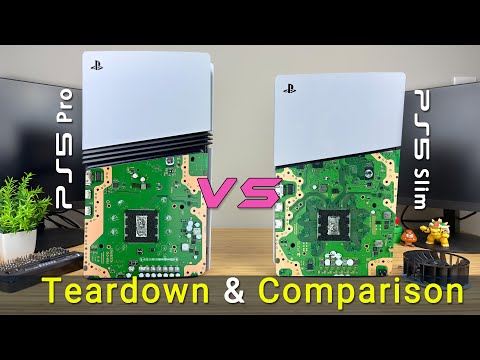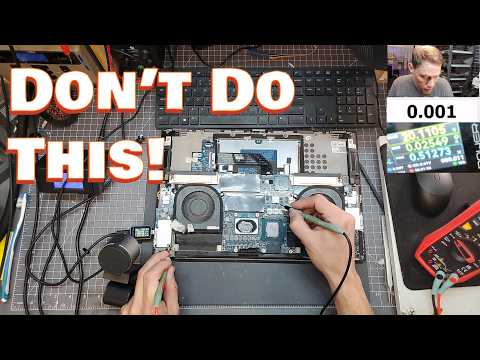PS5 Pro Teardown and Comparison with PlayStation 5 Slim

Hello everyone, welcome to HowFixit. Today, we're diving into a full teardown of the PlayStation 5 Pro and comparing it to the PlayStation 5 Slim. We’ll explore their internal components, cooling systems, power, design differences, and reparability. Before we start, here’s a list of tools required for the PS5 Pro: Screwdriver set: Torx T8 Security, Phillips 1 Tweezers Plastic pry tools I’ve included links to all these tools in the video description below.
I recommend using a magnetic mat to organize screws as you go. The PS5 Pro has screws of different sizes, so it’s important to keep track of each one. And you won’t have to worry about losing screws; they’ll all be securely attached to the magnetic mat. So, let’s get started. Disassembly The top covers are held in place by clips. Lift the front edge to release them. Let's start our disassembly by removing the fan. Disconnect the fan cable, then use a Torx T8 Security screwdriver
to remove the four screws securing the fan. Now, lift out the fan from the console case. At first glance, the PS5 Pro fan appears similar to the PS5 Slim fan, with the same blade size and design. However, the PS5 Pro’s fan is slightly taller, which increases its air displacement capacity, allowing it to push more air through the system with each rotation. This added airflow is
particularly beneficial for the PS5 Pro, as it may produce more heat due to its upgraded hardware. Additionally, the enhanced cooling could help maintain lower fan speeds during regular use, making the system quieter overall. The heatsink is readily accessible, allowing easy dust cleaning without removing the warranty sticker. The expansion slot still supports multiple subtypes of the M2 SSD form factor. After removing the next cover, we have access to the installation of the disc drive.
CMOS Battery Now, we see a removable metal bracket that covers the CMOS battery, making it quick and easy to replace. To access it on the PS5 Pro, you only need to remove one screw with a Phillips 1 screwdriver. A reminder: a faulty or dead CMOS battery can cause the system clock to reset, which may impact access to digital games. The PS5 relies on its internal clock to verify game ownership and license validity, so if the CMOS battery fails, the system might struggle to validate these licenses, potentially preventing gameplay—even with an internet connection. Although CMOS batteries typically last 3 to 10 years, they can
fail sooner. In contrast, the PS5 Slim requires complete disassembly to reach the CMOS battery. Note on Warranty Stickers The warranty sticker conceals a single screw securing the plastic cover. The PS5 Pro hardware warranty is one year from the original purchase date, and removing this sticker may void the warranty. In the United States, you’re protected by the Magnuson-Moss Warranty Act, so removing this sticker should not void your warranty. Similar laws exist in Australia, Canada, the United Kingdom, New Zealand, and the European Union. Elsewhere, however, this may void your warranty.
Disassembly Flip the console over, remove the covers, and unscrew the two screws. The CMOS battery holder is on a removable board, which can be easily replaced if damaged. In the PS5 Slim, the battery holder is soldered to the motherboard. Disconnect the antenna cables and set them aside. The heatsink tubes block access to two screws and the metal bracket, so we’ll need to remove the heatsink to proceed. Using a plastic pry tool, carefully lift the heatsink at the bottom. The heatsink is attached with a thermal interface, which may be reused if it remains elastic. When reassembling, I’ll show you how to reattach it without losing thermal conductivity.
Remove five screws from the metal cover that protects the front panel cable. Use the point of a spudger to push the metal latch to unlock the connector. Keep the latch and carefully pull the cable straight out of its socket.
Next, unscrew the top metal plate. Use a spudger to pry the top metal plate. Work your way around the perimeter until it separates. It may take some force to separate the plate because thermal pads bond the metal plate to the main board. Comparing the Top Metal Plates The PS5 Pro’s top metal plate features two heat pipes, a larger top heatsink, and an additional bottom heatsink, whereas the PS5 Slim has a single heat pipe and heatsink. However,
the heat pipe on the PS5 Slim directly contacts components, which I think could be more efficient. Back Sides Motherboard Comparison Now, let’s compare the PS5 Pro and PS5 Slim motherboards. The back sides of both boards are quite similar, featuring an SSD controller with a NAND memory chip. Both boards have 16GB of GDDR6 memory across eight soldered chips. However, the PS5 Pro motherboard includes an additional 2GB of DDR5 memory, which is dedicated to the operating system. This means that the PS5 Pro reserves the full 16GB of GDDR6 for gaming tasks, while
the PS5 Slim shares its 16GB of GDDR6 between both the operating system and gaming functions. Let's continue disassembling to remove the motherboard from the housing and compare the front sides. Remove the two screws securing the tension bracket on the motherboard, alternating turns to maintain even pressure. Avoid fully unscrewing one side at a time to prevent damaging the APU chip. Remove two more screws securing the mainboard. Carefully lift the bottom left corner of the motherboard with a spudger, separating it from the power supply prongs. Front Sides Motherboard Comparison Now, let’s take a look at the front sides of both motherboards. The main upgrade in
the PS5 Pro is its GPU, which features 67% more compute units than the PS5 Slim. It also boasts memory that’s 28% faster, enabling the system to render games and action sequences up to 45% faster overall. This marks a significant performance boost. To put it into perspective, the PS5 Pro's GPU delivers 16.7 TFLOPS of power, compared to the 10.28 TFLOPS in the base PS5 Slim. Both game consoles use liquid metal for best thermal conductivity, and this liquid metal is contained within an insulated, foam-cushioned pouch to keep it securely on the chip’s surface. On the front side, we also find the second set of
NAND chips, as well as the same input/output controller, LAN module, and Wi-Fi module. Comparing the Cooling System Now, let’s examine the PS5 Pro’s cooling system. If you look closely at the heatsink block that contacts the silicon chip, you’ll notice surface ridges. These protrusions likely enhance contact with the liquid metal, helping to keep it evenly distributed over the entire APU chip when the PS5 Pro is positioned vertically. This design minimizes the risk of liquid
metal pooling at the bottom of the silicon chip, which can reduce cooling efficiency. In contrast, the PS5 Slim’s heatsink block is flat. Some users reported that, when used vertically, the liquid metal in the PS5 Slim tended to shift, causing the console to overheat. The addition of ridges in the PS5 Pro’s heatsink block seems to address this issue. If you have other thoughts on the purpose of these ridges, feel free to share them in the comments. When comparing the cooling systems, the PS5 Pro has more heat pipes than the PS5 Slim, even though both models feature similarly sized aluminum heatsinks. These additional pipes allow
for faster and more even heat transfer from critical components to the heatsink, which helps maintain lower, stable temperatures and prevents hotspots. The design also boosts thermal capacity, enabling the PS5 Pro to handle the increased heat generated by its more powerful hardware without throttling performance, thereby improving system reliability and extending its longevity. In terms of weight, the cooling systems of these two consoles differ as well: The PS5 Pro cooling system weighs 609 grams. The PS5 Slim cooling system weighs 491 grams. This makes the Pro version’s cooling system 118 grams heavier.
Power Supply The PS5 Pro’s power supply is 420 watts, larger and more powerful than the Slim's 372 watts. The PS5 Pro’s APU has the model number ADP-420DR, while the PS5 Slim has the model number ADP-400GR. The PS5 power supply's AC input voltage range is universal. These power supplies can automatically adjust to different input voltages, allowing them to be used globally without requiring additional converters.
Power button board with USB-C ports Separate the front panel from the plastic housing. The front panel contains antennas and a power button board with USB-C ports. These two boards are very similar, although they have different part numbers.
Conclusion This concludes our PlayStation 5 Pro teardown and we can sum it up. The PS5 Pro is designed with enhanced cooling and ease of maintenance, making it more suited for high-performance and long-term reliability than the PS5 Slim. The Pro's taller fan and additional heat pipes allow it to manage heat more effectively, which is important given its more powerful hardware. This leads to better airflow and potentially quieter operation, as the system may not need to increase fan speeds as frequently. Maintenance-wise, the PS5 Pro offers easier CMOS battery replacement with a single screw, while the Slim requires full disassembly. The Pro's removable battery holder also adds resilience compared to the Slim’s soldered design, which is more difficult to repair.
The Pro’s cooling system includes a unique heatsink design with ridges, reducing the risk of liquid metal shifting during vertical use—a concern reported by some PS5 Slim users. The heavier cooling system and additional heat pipes in the Pro allow for better heat transfer and stable temperatures, enhancing performance and system longevity. Overall, while the PS5 Slim is a streamlined, efficient model, the PS5 Pro is built with better cooling, extra memory dedicated to the OS, and easier maintenance features, making it a more robust choice. Reassembly When reassembling, you can reuse the liquid metal on the APU chip and heatsink by spreading it evenly over both surfaces with a lint-free swab. Liquid metal typically remains effective for at least five years before its performance starts to degrade, so replacing it is seldom necessary.
However, if you need to replace it, check out my other tutorial linked in the video description. When installing the mainboard, pay close attention to the metal prongs that need to connect to the power supply. Ensure that the two notches align correctly, indicating the mainboard is properly seated in the housing. Secure the mainboard with two screws. Next, position the bracket with the plastic arms first, ensuring the pegs fit into their designated cutouts. Place the metal bracket on top of the plastic one, aligning the screw holes. When tightening the screws,
alternate between them, turning each a few times at a time to apply even pressure. Avoid fully tightening one screw at a time, as this could damage the APU chip. When installing the metal plate, ensure that the blue thermal pads are in place. Missing thermal pads may lead to overheating. Use Thermal Putty to replace any missing, damaged, or dried-out pads; a link to Thermal Putty is provided in the video description.
Secure the metal plate with screws. Insert the cable into its socket, set the metal cover, and fasten the screws. Attach the antenna cables to their original positions and connect them to the mainboard.
When we removed this heatsink, we disrupted the integrity of the thermal interface. You can attempt to reinstall the heatsink with the existing thermal interface if it remains elastic, as it should still transfer heat effectively. If the heatsink does not stay in place, consider using Thermal Putty or a similar high-conductivity thermal interface. Check its thermal conductivity (measured in watts per meter-kelvin)—the higher the conductivity, the better the material transfers heat. I’ve included a link for recommended materials in the description. Press the heatsink lightly but avoid excessive force to prevent bending the heatsink fins. Install the CMOS battery module and connect its cable to the mainboard.
Install the plastic cover over the mainboard and secure it with screws. Next, install the fan, connect its cable to the socket, and secure the fan with four screws. To install the covers, align the hooks into the cutouts along the case edges, then pull the opposite edge of the cover until the grooves snap into place. Repeat this for the remaining three covers. Flip your PlayStation over and fasten the two additional screws.
Finally, install the last two covers to complete the assembly. I really appreciate you watching my video; if you have any questions about maintaining your PS5 Pro, drop them in the comments. If you found this guide helpful, give us a thumbs up and subscribe for more tech tips and guides. Visit our website for more tech insights and Do-It-Yourself guides. Remember, every tech challenge is an opportunity to learn and grow.
Thank you for watching HowFixit, and see you in the next video!
2024-11-17 17:50


